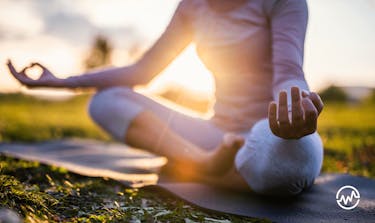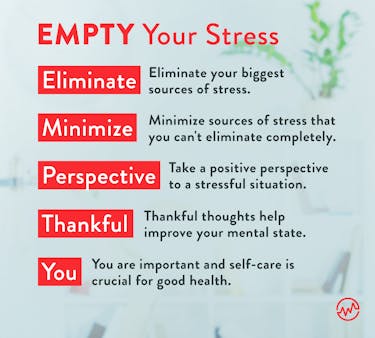

Get Access to 250+ Online Classes
Learn directly from the world’s top investors & entrepreneurs.
Get Started NowIn This Article
Deadlines. Bills. Traffic. Phones. Weather. Taxes. Entrepreneurial pursuits. The livelihood of your children. The list of things that can cause stress can be endless.
Chances are that you either have been stressed recently, or you are stressed as you read this. A recent Gallup poll found that more than half of Americans — 55% — admit to feeling stress during the day.
While you can’t control every stressful situation that comes your way, you can control your response to that situation. Instead of stressing, there are healthy ways to create resilience, an inner strength that helps you to bounce back from negative experiences.
This is the topic of the course Stress Less: How To Boost Your Mood, Lower Your Anxiety, & Avoid Burnout by Strengthening Your Resilience Muscle, taught by ER Physician Jamie Hope.
In this article, we’ll break down a few of the keys to stressing less that Jaime teaches:
- Understanding what stress is and how it’s created in the body
- Identifying when you’re stressed
- Using tactics to reduce and/or eliminate stress
Assess Your Stress
Let’s begin with understanding what stress is. Here’s a question for you: imagine that you recorded yourself for a day and then watched this video, paying close attention to your facial expressions and your energy levels.
So how would you look? Happy, energetic and excited? Or tired, frustrated and unhappy?
If your answer is the latter, the culprit could be your stress levels. This is one way to assess your stress. Another way to assess your stress is to ask yourself any of the following questions:
- How are you feeling? Do you feel at your best?
- Is anything hindering you mentally or clouding your mind?
- Do you feel any pressure?
- Are you doing too much?
- Are you in a hurry to get something done?
The reality is that stress — defined as “a state of mental or emotional strain or tension resulting from adverse or very demanding circumstances” — can harm you mentally and physically, and take a toll on your passions and your personal relationships.
As you begin to assess your stress, it’s important to understand that the nervous system in your body shifts between two different states: sympathetic and parasympathetic.
Parasympathetic State
The parasympathetic state is your normal relaxed state of mind. Think about relaxing at home after a long day of work, or enjoying a dinner with friends. In these situations, you’re likely in the parasympathetic division.
Sympathetic State
Once your stress levels begin to rise, your body goes into the sympathetic state. In a sympathetic state, your body is in the fight or flight mode and adrenaline is released to help the body cope in this stressed state.
The sympathetic state is your body’s defensive mechanism, meant to be a short burst of energy to help you survive an attack in an emergency. For generations that came far before us, this energy burst could help save someone’s life while being chased by a wild animal in a deep forest.
Today’s “attacks” can be emergencies, but they also take the form of deadlines, traffic, and bills.
If you tend to stay in the sympathetic state, your body switches from releasing adrenaline to releasing cortisol, the long-term stress hormone.
High levels of cortisol in the body can lead to:
- weight gain
- decreased immunity
- fatigue
Before you read any further, answer this quick question: What has been your personal ratio of parasympathetic versus sympathetic states in the last week?
Would you say 4 days out of 7 were spent mostly in the sympathetic state? Maybe more? Maybe less?
Write down that ratio and then measure it the following week to see if you’re headed in the right direction or the wrong direction. Simply being aware of your stressed state is progress. Next, we’ll discuss specific effective strategies to stress less.
Resilience Rx Strategies
You realize that you’re stuck in a sympathetic state — so how do you get out of it? Here are 13 ways to combat stress when it hits.
Hard or Soft Coping

When most people think about stress-relieving activities, they think about relaxing in nature or resting at home. A nice bubble bath or a massage can also do wonders for your frazzled nerves.
Sometimes though, you may need a more aggressive outlet to cope with stress. When this happens, find a safe way to let out your stress in a hard way. This can take the form of hitting a boxing bag or pillow or rocking out to fast-paced music.
Soundtrack Your Life
Music can have a powerful effect on our mood. Use this to your advantage by finding songs to match your desired mood. If you feel stressed, you can put on soothing music, such as slow jazz. If you’re exhausted and want to feel motivated, try to find a song that pumps you up.
After you identify a few songs, make a playlist and use it to your advantage. As time goes on, you may even find yourself humming these songs when the situation arises that you need this motivation or relaxation.
Reframe The Situation
If you want to stress less, you can take stressful situations and reframe them. Instead of thinking negatively, try to look at it from a different perspective. Allow your mind to put the situation in a prettier frame that takes the stress out of the picture so to speak.
For example, when you get cut off in traffic you can easily feel your blood start to boil. Instead of thinking of the driver as an inconsiderate person and feeling adrenaline flood your system, reframe the situation in a positive light. The driver could have been driving his wife to the hospital because she’s gone into labor or could have been in some other emergency situation.
This can help drain the stress away from the situation and reframe it into an understandable necessity.
Find Your Mantra
When you hear the negative talk in your brain, cut it off. Tell your brain what you want it to believe and it will. After all, repetition is the key to learning.
Find yourself a positive and effective mantra — such as “relax”, “you can do this” or something else that appeals to you — and repeat that phrase to yourself.
Meditation

Do you find turning off your brain seemingly impossible, thoughts constantly coming and going? That’s what meditation tries to help.
For some, guided meditation while maintaining a still body works. For others, active meditation is more effective. Doing things like going for a run or biking can help someone to turn off their mind and enjoy the stillness of the moment. Your body might not be still, but your mind is enjoying a quiet break.
Remember The Good
Sometimes taking a step back and remembering how well you’ve done in the past can help you to stress less. You’ve faced obstacles before and you’re still kicking. Don’t forget these victories, no matter how small.
Make a list of the following:
- things you’re the proudest of
- the obstacles you’ve overcome
- the milestones you’ve reached
- the accomplishments you’ve achieved — big and small
If you’re stuck in a sympathetic cycle and stress, try to look back at this list or make a new one to put things in perspective.
Ask For And Accept Help
Asking for help can be hard because we all have pride. But think about the most successful people you know. Do you really believe that they don’t accept help from others? Most likely, they have a team of people that help them to be the person they are.
If you want to get far in life, you need to be able to ask for help when you need it. That’s where the phrase “if you want to go fast, go alone, but if you want to go far, go together” comes from.
Practice Self-Compassion
We can be our biggest critic. We all have “ANTS”, or automatic negative thoughts. Just like you would get rid of real ants that have infested your house, try and get rid of these negative thoughts and give yourself a break.
Take A “Smoke” Break
Take a lesson from smokers. Throughout the day, they take regular breaks to engage in an activity that releases stress.
Instead of smoking, find a healthy activity that will release stress in short little breaks throughout the day, like walking, running, or going on a quick bike ride.
Create Human Connections
As humans, there are five groups of people we all should regularly associate with. Some of us may already have these people, and some may not. If you’re in the latter category, in order to find these people and connect, you need to be willing to share your story. That’s how people will relate to you and out of that community comes the tight bond of friendship.
The five people are:
- your role model
- your confidant
- someone who would take a bullet for you
- your tribe
- someone who looks up to you
Each of these five people can contribute something to your life that will help you to be the best version of yourself. They can also help you overcome obstacles and other stresses when they arise.
Stress Growth
Sometimes, stress can be so challenging that it seems impossible to stress less. But you can try to grow through the stress.
Find a lesson in your stressful situation and take it to heart. Instead of allowing the stress to beat you down and emotionally exhaust you, bounce back stronger than you were before.
Find Your Cause

Sometimes we need something bigger than ourselves for motivation. When we find something that gives us a reason to persevere — a purpose, whether it’s personal or united with a community — it can be amazing what we can achieve.
For some of us, our purpose could be our children. For others, it could be our employees. Maybe even a legacy.
Finding your cause will help you stress less by changing your mindset: instead of thinking about yourself, your schedule and the things that cause stress in your life, you will be thinking about how you can help someone or something else.
There's another way that it can be a motivating force to stress less. The reality is that whatever your cause may be, if you want to see it succeed, you have to take care of your health (and stress less) in order to do all you can to help the process. So when stress knocks at the door, realize that you have to do everything you can to reduce it — or else it may rob you of effecting the change you want to see in the world or completing your purpose.
Breathe
You can calm your entire body by practicing calming breathing techniques. The most effective is square breathing.
Here’s how to do it: take four seconds of breath in and four seconds of breath out, then four seconds of breath in and four seconds of breath out.
Repeat this until you can feel your body relax fully.
EMPTY Your Stress
Now that you know how to get your body back to the parasympathetic state, the goal is to maintain this state instead of switching between sympathetic and parasympathetic.
Jaime teaches a proactive method that prevents and limits stress — it’s called EMPTY, an easy to remember acronym with tremendous power. Let’s take a look at each one in-depth.

E: Eliminate
Examine your life and find the biggest sources of stress. After you’ve done that, it’s time to find ways to eliminate it. This may take a little self-examination and honesty.
Notice when and where you start to feel yourself get stressed. Is it a certain person that causes this stress? Is it a client? A task? Find ways to eliminate these sources of stress.
In some cases, you can’t eliminate them altogether. When this is the case, try following the next step.
M- Minimizing
Minimizing the sources of stress that you can’t eliminate is the next best thing.
Sometimes your responsibilities may make it impossible to eliminate some sources of stress, but you can do your best to keep your exposure to this stress to a minimum. For example, if possible, try to physically limit the amount of time you spend around this stress trigger.
P- Perspective
When you encounter unexpected stress, try to change your perspective.
Take a more positive approach to your situation and try to find the silver lining in a stressful situation. A state of negativity will only make the stress worse. Finding something positive about it can put you at ease.
T: Thankful
Thankfulness and gratitude have been proven to help the mental state of people who practice it — and it lowers stress levels.
Do you best to take note of the things you are grateful for — try writing them down — which can turn a stressful situation into a realization of thankfulness.
Y: You
You are important. Self-care — the stress antidote — is crucial for good health.
Taking care of yourself — such as exercising — on a regular basis can help balance your life and prevent stress before it happens.
It can be hard to take time for yourself. Many people struggle to make this a priority because they feel like self-care is selfish. But there’s a reason why you are instructed to put on your oxygen mask on an airplane before you help someone else put theirs on in the event of an emergency: you are ensuring your ability to care for all your other responsibilities when you care for yourself.
Ensuring that you stress less should be a part of your self-care routine.
To understand what self-care looks like Jaime teaches that there are four main habits:
Eat
Eating healthy consists of:
- putting nourishing foods in your body, not junk food
- drinking smart by ensuring that you’re hydrated
- increasing your vegetable intake
- avoiding convenience foods (such as fast food)
- maintain portion control
Sleep
Ensuring that you’re sleeping enough enhances your energy levels, mood, and productivity. A few ways to do this are:
- making your room cool, dark and quiet
- banning electronics while you sleep
- making a sleep a priority by setting an alarm to go to sleep
Burn
Burning is about exercising and keeping your body in the shape required for your lifestyle. Here are a few tips:
- don’t do too much too soon: by exercising too much, you may injure yourself
- integrating exercise into your daily life, such as walking or biking to and from work
- join an exercise community to build relationships and have accountability
Release
Release is about giving your body rest.
- Find ways to relax, and make it a priority in your schedule
- Let go of the idea of being perfect,
- Don’t be afraid to ask others for help
You can read more about these health pillars in our article “The Complete Guide to Getting Healthy”.
Stress Less
The key to stressing less is understanding what stress is, identifying it, and then finding a solution to it.
Put what you’ve learned in this article to the test. The next time you experience stress:
- use the resilience Rx strategies to reduce stress when it strikes
- be proactive and EMPTY your stress so that the stress doesn’t become a cycle
If you’re looking for even more stress less tactics, watch Stress Less: How To Boost Your Mood, Lower Your Anxiety, & Avoid Burnout by Strengthening Your Resilience Muscle.
With practice and discipline, you may be surprised at how you can control your response to stress.






